Breathing exercises play a crucial role in enhancing the sound quality of the hulusi. Let's delve into the various ways in which this is achieved.
First and foremost, having a controlled and efficient breathing technique allows for a steadier and more consistent air supply into the instrument. This means that the sound produced is less likely to waver or break, creating a smooth and continuous tone.
When you engage in breathing exercises, you strengthen the muscles involved in inhalation and exhalation. This added strength enables you to project a stronger airflow, resulting in a louder and more resonant sound. For instance, imagine being able to hold a long note with a full and rich volume, filling the space with a beautiful tone that captivates the listener.
Good breathing control also gives you the ability to vary the intensity and speed of the air flow. This allows for a wide range of dynamics in your playing. You can go from soft and gentle notes that convey a sense of delicacy to powerful and bold sounds that add drama and emphasis. By consciously manipulating your breath, you can paint a vivid musical picture and evoke different emotions through the sound of the hulusi.
Moreover, precise breathing helps in achieving better pitch accuracy. When the air flow is consistent and controlled, it becomes easier to hit the correct notes precisely, reducing the chances of pitch fluctuations or off-key sounds. This is essential for playing complex melodies and harmonies accurately.
Let's take a moment to consider the specific breathing exercises that can have these beneficial effects. One such exercise is diaphragmatic breathing. This involves breathing deeply into your abdomen, allowing the diaphragm to expand and contract naturally. By focusing on this type of breathing, you tap into the full capacity of your lungs and gain better control over the air release.
Another useful exercise is to practice inhaling and exhaling through pursed lips. This helps to regulate the speed and pressure of the air, mimicking the controlled airflow needed when playing the hulusi. You can start by inhaling for a set duration, holding the breath briefly, and then exhaling slowly through pursed lips, trying to make the exhalation as smooth as possible.
In addition to these direct breathing exercises, activities such as yoga and pranayama can also have a positive impact. The focus on breath awareness and control in these practices translates well to the demands of playing the hulusi. For example, in yoga poses that require deep breathing, you learn to synchronize your breath with movement, which can enhance your ability to coordinate breathing and playing on the instrument.
Furthermore, consistent practice of breathing exercises helps to build endurance. Playing the hulusi often requires sustained periods of blowing, and having the stamina to maintain a good quality of sound throughout is essential. With improved breathing endurance, you can play longer passages without getting fatigued or experiencing a drop in sound quality.
It's important to note that the integration of breathing exercises into your hulusi practice should be a gradual and consistent process. Start with short sessions of focused breathing practice and gradually increase the duration and complexity as you progress.
For example, in the beginning, you might spend just five minutes a day on diaphragmatic breathing exercises. As you become more comfortable and proficient, you can extend this to ten or fifteen minutes and incorporate more advanced techniques.
Also, when you apply these breathing skills to playing the hulusi, start with simple melodies and gradually incorporate more challenging pieces. This allows you to focus on the breath control without getting overwhelmed by the complexity of the music.
Another aspect to consider is the mental aspect of breathing. Maintaining a relaxed and focused state of mind is crucial for effective breathing and, consequently, for the sound quality. Stress or tension can lead to shallow and erratic breathing, negatively affecting your playing. So, incorporating relaxation techniques such as meditation or deep breathing before playing can set the stage for a more controlled and enjoyable performance.
Let's look at some real-life scenarios where improved breathing has made a significant difference. Imagine a beginner struggling to hold a note for more than a few seconds due to poor breathing control. With regular breathing exercises and practice, they are able to sustain notes for much longer, adding depth and expressiveness to their playing. Or consider a musician who previously had difficulty achieving a consistent volume throughout a piece. Through dedicated breathing training, they can now effortlessly control the dynamics, creating a more engaging and professional-sounding performance.
In conclusion, breathing exercises are not just an accessory to playing the hulusi but a fundamental aspect that can truly transform the quality of your sound. By committing to a regular practice of these exercises and consciously applying the skills gained to your playing, you open up a world of possibilities for creating beautiful and captivating music with the hulusi. So, take the time to breathe deeply, master the art of controlled breathing, and watch as your hulusi playing reaches new heights of excellence.
I hope this extensive discussion has provided you with valuable insights into the relationship between breathing exercises and the sound quality of the hulusi. If you have any further questions or need additional clarification, please don't hesitate to ask.
SUNRISE MELODY Electric hulusi flute instrument
Chinese hulusi flute instrument has a unique ethnic style and is extremely ethnic.
And it has a good volume and 10 timbres, it is easy to learn and simple to use, especially suitable for beginners.
6 Major Core Selling Points, a variety of innovative functions to meet different performance needs:
10 kinds of timbres
Touchable octave
Connect headphones
Four fingerings
Built-in battery
Built-in speakers



